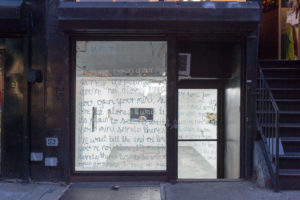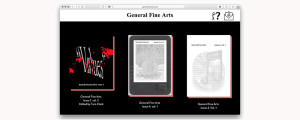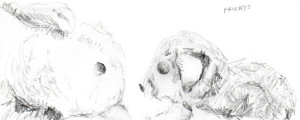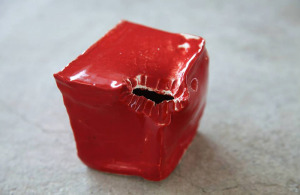The thing about Frieze London 2015 is that it’s kind of going on or happening anyway, even if you don’t go to it. You don’t need to go to the big ‘thing’ because you know it’s happening. It sort of frames something and allows things outside of that frame to use its edges and say – we’re doing this, thanks for the frame, ‘cos we gonna do another thing’ [sic]. So you walk around and bus around and get a sense of the state of things in relation to the big ‘thing’ that hovers in the mind. It sort of presides over the whole experience until, if you keep walking far enough, on the fringes, you can turn around and it’s almost gone.
Walking up Kingsland road into Hannah Perry’s show Mercury Retrograde at Seventeen Gallery might seem like walking into a shop. Not a shop to buy things but a dead shop that communicates through arrangement and display. There is music playing whilst looking, cut up pieces of ambience, and then beats come on. The gallery is divided by hanging rubber latex, dark cherry red, that allocate areas where things are on display –pieces of printed and painted aluminium. ‘I don’t want you to feel like I have the dominance over anyone’ (2015) shows an image of a cracked and smashed iPhone printed onto corrugated aluminium. I look at my cracked and smashed iPhone and think –‘this is how I find out about the big things’. A series of four works, ‘Gas Lighting 3, 6, 2 and 1’ (2015), are pieces of dented and punched out aluminium sheets immaculately finished in autobody enamel, the cherry reds and blueberry colours matching the hanging latex. In front of these sitting on the floor, ‘Will You Be Topless’ (2015) is what looks like part of a wrecked car, again with a perfect gloss finish of cherry red autobody paint and a piece of rubber draped over it. If this is a shop then now it’s a workshop –a car spray and repair shop.

Then travel to Evelyn Yard, to see Jamie Jenkinson’s show Video. The press release speaks of Jenkinson’s interest in ‘digital phenomena’ and his ongoing investigation into expanded cinema. Before I get much time to look around one of the gallerists comes to tell me as much about the show as possible, talking about the importance for the artist of ‘information transfer’ and the ‘glitches’ and ‘noise’ that occur in this process. The centrepiece, ‘Colour Correction’ (2015) is a projected colour field that shifts its colour hue slowly over ninety minutes. This work and all the other video pieces were shot on iPhone 6 which I am told is important for the artist because of its everyday relation to the body. Because everyone has iPhones. A monitor on the floor shows ‘Net Storage’ (2015), a durational still(-ish) close shot of a piece of netting –the pun opening up a dialogue on how things can be stored: as objects –what things can slip through the netting? Or data –what information is lost in the transfer to the iPhone? Whether the artist agrees with the ‘information transfer’ spiel or not is unclear, what is more apparent in the show is an interest in the formal qualities of film/video and (expanded) cinema. ‘Digital phenomena’ may be casting too broad a net.
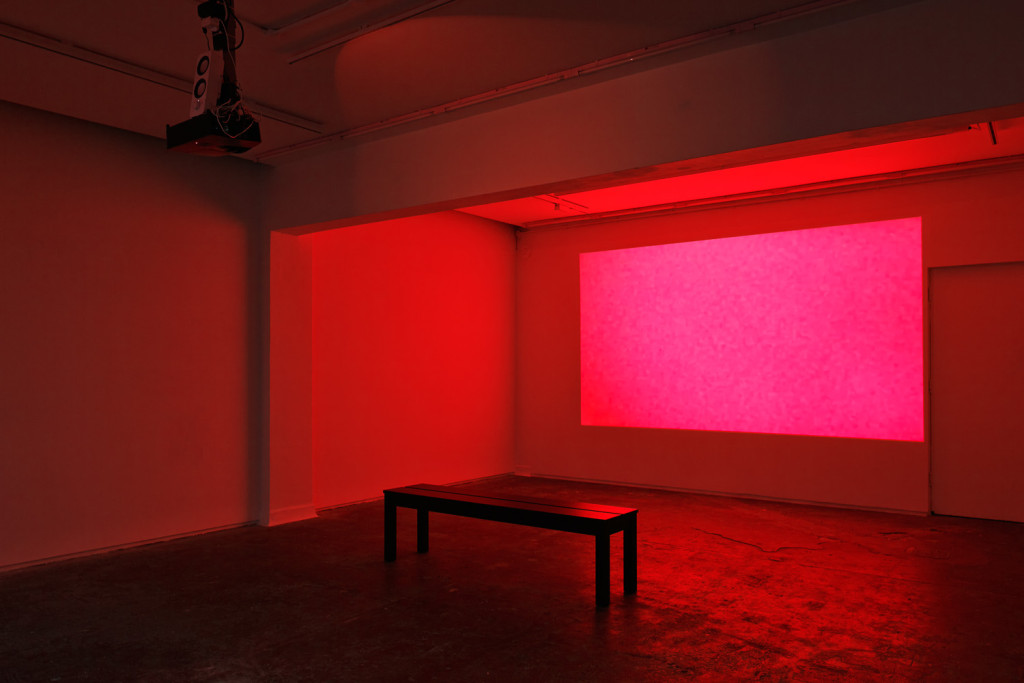
I get on a bus and go to Cabinet gallery for the opening of Mark Leckey’s new work ‘Dream English Kid 1964 – 1999 AD’ (2015). The place was pretty packed and the bus stop outside was like some sort of hang out if you were either waiting for the 243 or waiting to get into the gallery. I go inside and from the surround sound system I hear the words, spoken through some NASA style intercom, “3 – 2 – 1 – Mark” and so begins a journey through found footage of The Beatles, NASA rockets, British public information broadcasts and Joy Division gigs. The film is kind of a biopic. The artist’s memories of mediated events re-found as images now feel like they can transcend any ‘real’ memory, creating a kind of new ‘present’ memory. A scene from a 1970s public information broadcast shows a frisbee landing precariously on an electricity pylon, one of several references to electrical energy in the film –and the subtext running through the work could be amplification. From Joy Division’s electric guitars through to the saturation of images that comes with digital technology, it folds back to the amplification of the memory to something greater than a dream.

At Pilar Corrias is a huge wall size projection of the latest moving image work by New York-based artist Ian Cheng, who in 2012 created a 3D animated music video for Liars, where humans and rabbit characters dance and twist and rip and tear apart from their rigs. The current exhibition, Emissary Forks At Perfection, continues Cheng’s distinct imagery and colour pallet. Out of the grey landscape, orange dogs play and speak and chase a corpse like a humanoid avatar through vibrant green foliage and littered water bottles. Beyond the surface qualities is the interesting fact that this work is a ‘live simulation’ of ‘infinite duration’. A flow chart on the wall when you come in seems to hint at the complex algorithmic procedures that might be at play, with the quite funny headline, ‘Horizon of volatile uncertain complex ambiguity (VUCA)’. The press release says ‘a story may escape its classical fixity and indefinitely procrastinate its conclusion’, so I wondered if they shut the power off at night.

I walk to Deptford to get to Res. Here artists Laura Morrison and Beatrice Loft Schulz are working as part of a project called Bain Marie. “What does Bain Marie mean?” I say to Schulz. She tells me it could be something like a thing that melts chocolate slowly so as not to burn it, kind of warming it up. I started to think that the space they have started creating is having the same effect. Some rubber tiles cover part of the floor and arranged across them are plenty of books that the artists had brought with them –novels, Finnish poetry, theory –all sorts. Over the other side of the room are a couple of portable old fabric and wooden makeshift beds, upon which each has a vintage dress draped over it. The materiality of the objects creates a sense of warmth in the space –paper, wood, fabric, nylon. Also drawings are being made onto veneered wood –a fox, a map of slow worms, a vagina, an arsehole. Both artists seem reluctant to consider it a collaboration, preferring to state that they are working on their own separate things. This strikes me as interesting, a beginning point for a discussion on the nature of collaboration and what it means to even state the word in different situations. Schulz mentions the notion of ‘the collaborators’ during wartime. A performance event is planned for October 30 and, I believe, should be highly recommended.
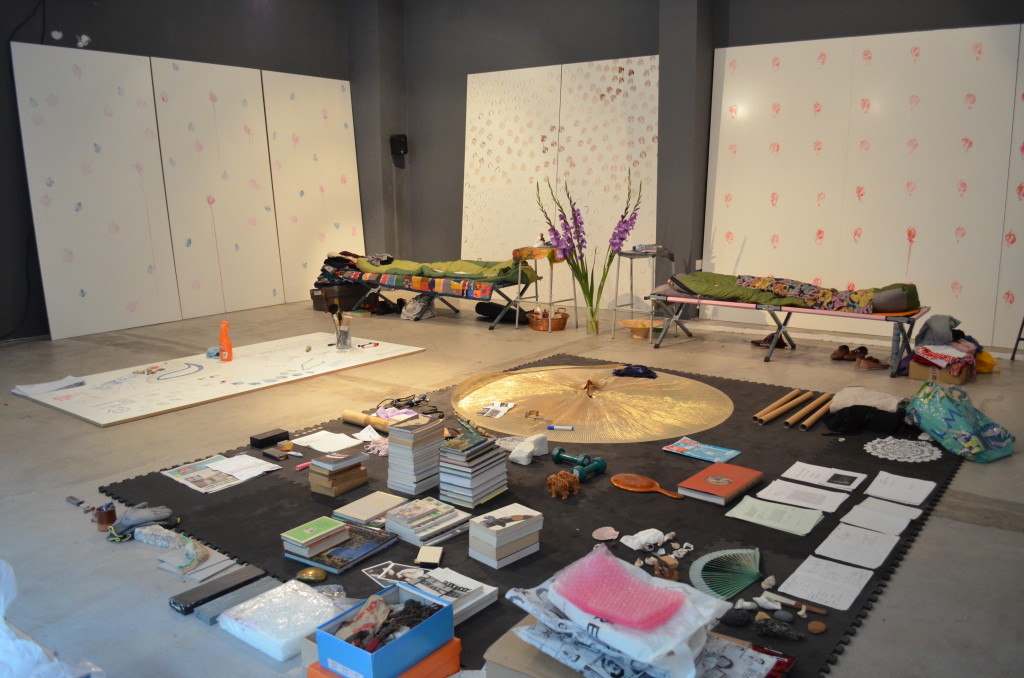
Then I walk to Peckham to get to Assembly Point to an event from East Anglia Records. EAR is an ongoing project by Harry Bix which started at the Slade School with his ‘album launch’ nights. Here, at Assembly Point, the lights have been turned off and there is a smoke machine and a stall to buy EAR branded merchandise. The place is pretty rammed. Taylor Smith reads some beat style poetry about curry clubs and petrol stations, Harley Kuyck Cohen animates a talking Toby Jug with a torch. Lea Collet presented ‘Ricardo’ in drag brandishing a screen in front of another screen. Audience participation gets interesting with Richard Seaholme’s longer piece –interesting because of the audience’s growing disinterest and Seaholme’s manner in which he continues on regardless, occasionally telling the crowd to shut the fuck up. Leaving before the end I missed the performance by Ulijona Odišarija. I had seen a previous incarnations of the work –the artist posed enigmatically in front of a camera to the soundtrack of Tina Turner’s ‘Simply the Best’, while the image is simultaneously broadcast on a screen. I get in touch with the artist to ask how it went this time. “It’s basically the same as before but I was more of Sweatlana this time with a JLo-esque weave and spotlight in my face.” Who is Sweatlana, then? “She is sort of cool, sitting in the spotlight with a lot of drama in her face and all eyes on her”.
Thinking about “all eyes on the spotlight” I think that if the light shines too bright then you can get stuck in the glare of its presence –the big ‘thing’. But transiting the streets by phone light allows smaller things to become much brighter. **
Click arrow, top right, for exhibition photos.
